Welcome to Integrated Marketing Program. In this topic, you will learn about:
- Strategic planning
- Mission statement
- Company objectives and goals
- Business portfolio
- Marketing planning
- Contents of marketing plan
Strategic planning is essentially, the game plan for the long-term survival, improvement and growth of your company aiding in maintaining a strategic fit between its goals and capabilities and the fluctuating marketing opportunities. When there is no strategic plan in place, the best the company can hope to achieve is the maintenance of the status quo.

When comparing strategic planning to the marketing strategy, you will see that they are similar in that their broad outlook is customer-focused.
At the corporate level, the company starts the strategic planning process by defining its overall purpose and mission and turning it into detailed supporting objectives that guide the entire company. Following on from that, the company decides what is the best-suited portfolio of businesses and products are, and will determine from there how much support to give each one. In turn, each business and product will develop detailed marketing and other departmental plans that support the company-wide plan. Thus, marketing planning occurs at the business-unit, product, and market levels that helps to support company strategic planning with more detailed plans for specific marketing opportunities.

Let us take a look at the company, Starbucks. Starbucks didn’t sell just coffee, they have said “the Starbucks coffee company provides an uplifting experience that enriches people’s lives one moment, one human being, one extraordinary cup of coffee at a time.” At Starbucks, the aroma of coffee, the sound of the beans grinding, watching baristas blend and brew the brand’s specialty coffees all became as much or more a part of the customer experience, than the coffee itself. Starbucks opened stores everywhere at a rapid pace, one three-block stretch in Chicago contained six stores and in New York City, there were two Starbucks in one Macy’s store. One satirical publication headline read: “A New Starbucks Opens in the Restroom of Existing Starbucks.” Starbucks began to evolve into more of a caffeine filling station, competing with the likes of McDonald's, for many of the same customers. At one point, Starbucks needed to “reignite the emotional attachment with customers” and Starbucks’ store managers participated in a morale-building re-orientation to emphasise the company’s mission. The company closed all its U.S. locations for three hours to conduct nationwide employee training, based on producing satisfying customer experiences. Thus, began a process of continual renewal which reignited “The Starbucks Experience” through new products, innovative store formats and new platforms for engaging customers.
Steps in Strategic Planning
The company’s marketing team understand that strategic planning as an ongoing process and is one that proceeds from defining a shared purpose, leading to business growth. Below are the five steps of strategic planning.
Portfolio analysis:
- Define the mission:
- What business are we in?
- What customers should we serve?
- How should we develop the firm’s capabilities and focus its efforts?
- Evaluate internal and external environment:
- Situation or environmental analysis: SWOT Analysis
- internal strengths and weaknesses
- external opportunities and threats.
- Situation or environmental analysis: SWOT Analysis
- Set objectives:
- Objectives should be specific, measurable, attainable, and sustainable over time.
- May relate to revenue/sales, profitability, market standing, ROI, product development, customer satisfaction, social responsibility and other attributes.
- Establish business portfolio:
- Large firms often operate a range of different businesses (SBUs) that are called it's business portfolio.
- Develop growth strategies:
- Assesses the growth potential for a firms’ SBU’s
- Guides decisions on allocation of corporate resources to different SBUs
- BCG Growth-Share Matrix is popular
Levels of business planning
Business planning looks at the strategical planning with a birds-eye view, separating each step into three levels. These are:
- Planning done by top-level corporate management:
- Define the mission
- Evaluate the internal and external environment
- Set the organisational or SBU objectives
- Establish the business portfolio (if applicable)
- Develop growth
- Functional (market) planning (done by top functional-level management such as the firm’s chief marketing officer (CMO)):
- Perform a situation analysis
- Set marketing objectives
- Develop marketing strategies
- Implement and control the marketing plan
- Operational planning (done by supervisory managers):
- Develop action plans to implement the marketing plan
- Use marketing metrics to monitor how the plan is working.
The top-level (strategic planning) displays the “big picture”, while the bottom level (operational planning) specifies the “nuts-and-bolts” actions the firm will need to take to achieve their strategic goals. Whilst planning at the functional and operational levels, marketers must be consistent with the mission and objectives of the firm.
A mission statement is the organisations, purpose that should be market-oriented and defined in terms of satisfying the basic customer needs. It is recommended to keep the mission statement meaningful, specific, yet motivating to accomplish their mission in the larger environment. Forging a sound mission begins with the following four questions:
- What is our business?
- Who is the customer?
- What do consumers value?
- What should our business be?
Companies continuously raise these questions and answer them carefully to aim in emphasising the company’s strengths when developing their mission statement. For example, Google’s mission is to give people a window into the world’s information, wherever it may be found.

To inspire and nurture the human spirit – one person, one cup and one neighbourhood at a time.
Starbuck’s Mission
There is a clear distinction when comparing the company’s product-oriented and market-oriented mission.
See examples in the table below.
| Company | Product-Oriented Definition | Market-Oriented Definition |
|---|---|---|
| Starbucks | We sell coffee and snacks. | We sell “The Starbucks Experience”, one that enriches people’s lives one moment, one human being, one extraordinary cup of coffee at a time. |
| Panera | We sell fast-casual food in our restaurants. | We give customers “Food as it should be”: food that tastes good; food that feels good; food that does good things for them and the world around them. |
| We are a social networking app for posting photos and videos. | We help people capture and share the world’s moments. | |
| Home Depot | We sell tools and home repair and improvement items. | We empower consumers to achieve the homes of their dreams. |
| NPR | We are a public radio network. | We create a more informed public—one challenged and invigorated by a deeper understanding and appreciation of events, ideas, and cultures. |
| Sephora | We are a beauty products retailer. | We sell lifestyle and self-expression by helping customers to unlock their beauty potential. |
| Ritz-Carlton Hotels & Resorts | We rent rooms. | We create “The Ritz-Carlton experience”—a memorable stay that far exceeds guests’ already-high expectations. |
| Walmart | We run discount stores. | We deliver low prices every day and give ordinary folks the chance to buy the same things as rich people. “Save Money. Live Better.” |

A company needs to turn its mission into detailed supporting objectives for each level of management. What this essentially means, is that each manager should have objectives and be responsible for reaching the company’s goals that align with its mission. When a company implements a broad mission, it leads to a hierarchy of objectives that include business objectives and marketing objectives. It is important when developing marketing strategies and programs that they support the marketing objectives. Let us take CVS Health as an example. CVS Health is a health care company that views itself as a “pharmacy innovation company” (business objective), one that is “helping people on their path to better health” (marketing objective). The company’s motto “Health is everything” supports the company’s objectives.
A business portfolio is a collection of businesses and products that make up the company. The best type of business portfolio is the one that best fits the company’s strengths and weaknesses to opportunities in the environment, this involves two specific steps in the planning. When planning a business portfolio, the company must:
- analyse its current business portfolio and determine which businesses should receive more, less, or no investment.
- shape the future portfolio by developing strategies for growth and downsizing.
Portfolio Analysis
The major activity in strategic planning is business portfolio analysis, which is the process by which management evaluates the products and businesses that make up the company.
Management’s first step is to identify the key businesses that make up the company, this step is called strategic business units (SBUs). An SBU can be a company division, a product line within a division, or sometimes a single product or brand. The company next assesses the attractiveness of its various SBUs and decides how much support each deserves.
The BCG Growth-Share Matrix
The best-known portfolio-planning method was developed by the Boston Consulting Group (BCG), a leading management consulting firm. This BCG Growth-Share matrix shows the classification of company’s SBUs. Market growth rate provides a measure of market attractiveness and relative market share serves as a measure of company strength in the market. The Growth-Share Matrix defines four types of SBUs:
- Stars are high-growth, high-share businesses or products.
- Cash cows are low-growth, high-share businesses or products.
- Question marks, are low-share business units in high-growth markets.
- Dogs are low-growth, low-share businesses and products.
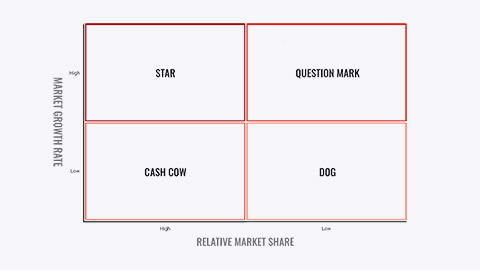
Under the BCG portfolio planning approach, the company invests funds from mature, successful products and businesses (cash cows) to support promising products and businesses in faster-growing markets (stars and question marks,) hoping to turn them into future cash cows.
The 10 circles in this growth-share matrix would represent a company’s 10 current SBUs. The company must decide how much it will invest in each product or business SBU. It must decide whether to build, hold, harvest or divest.
There can be draw backs of the growth-share matrix and these should be taken into consideration.
- Difficult, time-consuming, and costly
- Difficult to define and measure
- Provides little advice for future planning
- The Product/Market Expansion Grid
The Product/Market Expansion Grid

The product/market expansion grid shown above is a portfolio-planning tool for identifying company growth opportunities through market penetration, market development, product development, or diversification.
Market penetration
The first consideration must be if the company can achieve deeper market penetration. That is, make more sales to current customers without changing the original products.
Market development
Market development refers to identifying and developing new markets for its current products.
Product development
Companies could consider product development by offering modified or new products to current markets.
Diversification
Starting up or buying businesses beyond the firm’s current products and markets will help to diversify the product.
At times, company will take it upon themselves to downsize rather than expand. When a firm finds brands or businesses that are unprofitable or that no longer fit its overall strategy, it must carefully prune, harvest, or divest them.
There are many reasons that a firm might want to abandon products or markets, for example:
- the firm may have grown too fast or entered areas where it lacks experience.
- the market environment might change, making some products or markets less profitable, for example, in difficult economic times, many firms prune out weaker, less-profitable products and markets to focus their more limited resources on the strongest ones.
- finally, some products or business units simply age and die.
Develop and execute the marketing strategy
Marketing and other functional managers develop functional plans to achieve objectives. The effective implementation of the four Ps requires a great deal of planning and those steps are similar to those in strategic planning. The key difference relates to focus on issues relating to marketing mix. See the following four steps in market planning illustrated below:

Step 1: Perform a situation analysis
Situation or environmental analysis requires the use of a SWOT & PESTEL Analysis to help determine internal strengths and weaknesses as well as external opportunities and threats. See the slide below that illustrates each of these analytical tools.

SWOT Analysis
Managing the marketing function begins with a complete analysis of the company’s situation. The marketer should conduct a SWOT Analysis, with the goal being to match the company’s strengths to attractive opportunities in the environment while overcoming or eliminating the weaknesses and minimising the threats. During this process, an overall evaluation of the company’s strengths (S), weaknesses (W), opportunities (O), and threats (T) should be conducted.
The SWOT tool is a key tool in the marketer’s tool kit, this will be called on often in your career, especially when analysing business cases, let us have a look at the components below:
- strengths include internal capabilities, resources, and positive situational factors that may help the company serve its customers and achieve its objectives.
- weaknesses include internal limitations and negative situational factors that may interfere with the company’s performance.
- opportunities are positive factors or trends in the external environment that the company may be able to exploit to its advantage.
- threats are negative external factors or trends that may present challenges to performance.
Elements of the external environment
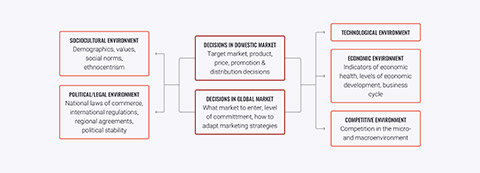
Elements outside the firm that may affect it either positively or negatively must be constantly scanned and monitored by businesses on an ongoing basis as part of their strategic planning process. Marketers seek to identify economic, competitive, technological, legal/political/ethical, and sociocultural trends, because these trends manifest as opportunities or threats to the business. Because these factors are external to the firm, marketers cannot directly control them, but they can respond to them when planning.
Step 2: Set marketing objectives
Objectives should be specific, measurable, attainable, and sustainable over time. They may be in relation other business attributes such as revenue/sales, profitability, market standing, ROI, product development, customer satisfaction and social responsibility.
Step 3: Develop marketing strategies
Marketing mix decisions identify how marketing will accomplish its objectives in the firm’s target markets. It is important to determine the target market(s) that are best suited to the firm’s offering need to be identified then the specific product, price, promotion, and place strategies that fit the market need to be developed.
Market segmentation and market targeting
Segmentation and targeting are a familiar and commonly applied approach in today’s modern marketing world with the key difference to previous marketing models which focused on the product, it instead focuses on the customer, the company’s key audience.
Marketing segmentation
In this stage, the marketer and relevant members should identify bases for segmentation, essentially grouping customers into groups based on similar needs and determining important characteristics of each segment.
Market targeting
Here, is it important to then evaluate the attractiveness, both potential and commercial attractiveness, of each segment and then proceed to selecting one or more segments.
The four P's of the marketing mix strategy
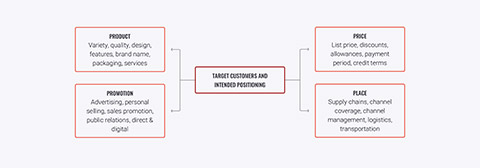
The marketing mix is the set of tactical marketing tools that the firm blends to produce the response it wants in the target market. This above image shows the four marketing tools, the four Ps.
- Product is the goods-and-services combination the company offers to the target market.
- Price is the amount of money customers must pay to obtain the product.
- Place includes the company activities that make the product available to target consumers.
- Promotion refers to activities that communicate the merits of the product and persuade target customers to buy it.
An effective marketing program blends the marketing mix elements into an integrated marketing program designed to achieve the company’s marketing objectives by delivering value to consumers.
Pricing strategy
Pricing strategy determines how much a firm charge for a product including wholesalers and retailers.
Setting a price is not an easy task, the marketer must consider cost and competitive factors, the price consumers are willing to pay, and the ability of wholesalers and retailers to mark-up the product and earn a fair profit. Typically, marketers set the price to wholesalers or retailers, and suggest a retail price which may or may not be adopted at the point of sale. Sometimes the firm bases its pricing strategy solely on cost, demand, or competitive issues. Other times, the wholesaler/retailer may also decide to apply a de-bundling strategy for prices, this is where the price of usually bundled items are separated and consumer is charged for it instead. For instance, the price of a furniture might have a set recommended retail cost applied, however, to assemble or deliver the furniture may come at an extra cost. Many consumers have expressed dissatisfaction with this approach, so price bundling is becoming more known- meaning the extra services are included in the price again.
Promotional Strategies
A promotional strategy is how marketers communicate a product’s value proposition to the target market. Marketers use promotion strategies to develop the product’s message and the integrated communications mix of advertising, sales promotion, publicity, direct marketing, personal selling, and new communications practices such as social media marketing that will deliver the message. As previously discussed, the marketing mix strategy must be devised with the intent of achieving marketing objectives, which in turn, contribute towards the achievement of corporate or SBU objectives.
Distribution Strategies
Distribution strategies outline whether marketers sell the product directly to the final consumer, or if instead they sell to intermediaries, such as wholesalers and retailers, who in turn sell to the ultimate consumer. Not all retailers are equal in terms of their merchandise quality and image therefor, determining the retailers that should carry the firm’s products is an important decision as they are representing the product also.
Using the internet as a distribution channel can save a firm money in the case of products or services that can be delivered “virtually”. For example, airlines used to pay travel agents a commission to book flights. The introduction of online travel agents such as Expedia contributed to the demise of over 80% of traditional travel agencies, as online vendors charged a drastically lower commission than did traditional agencies.
Step 4: Implementing and control the market plan
In practice, marketers spend much of their time managing the various elements involved in implementing the marketing plan. This involves exercising control over the plan in terms of both budget expenditures and performance. For instance, each action plan must include as accurate a budget as is possible as this allows management at the functional level to monitor budget expenditures and contact the appropriate operational manager if a particular budget line is exceeded within some specified time period. Managers must select the metrics to be measured as part of the formal control process. Actual performance on key objectives is measured (activity metrics) and comparing it to the numerical objectives previously set (outcome metrics).
- Activity metrics- this helps to measure and track specific activities taken within a firm that re-part the different marketing processes. For example, the number of calls a salesperson makes in a day can be measured.
- Outcome metrics- measure and tract specific events identified as key business outcomes that result from the marketing processes. For example the number of orders or the dollar amount of orders received from the sales calls.
ROMI (return on marketing investment)- is just one example of a marketing metric, others include measures such as new customer acquisition cost, customer retention rate, customer turnover rates, perceived product quality, customer satisfaction.
The control step actually manifest itself within a marketing plan through the inclusion of a series of action plans that support the various marketing objectives and strategies within the plan. Action plans also help managers when they need to assign responsibilities, create timelines, or develop budgets and measurement and control processes for marketing planning. Adjustments are made to plan as needed, if for instance, performance seems to be lagging in comparison to the objective that marketers are trying to reach.
Return on Marketing Investment (ROMI)
Return on marketing investment (ROMI) is a key marketing metric that is often incorporated into marketing objectives. Revenue (or profit) generated by investment in a given marketing program is divided by the cost of the program at a given level of risk. Marketers must think of marketing as an investment to accomplish goals, rather than simply as one of many expenses which provide little benefit/return to the firm. Although ROMI is a commonly used metric, there are several major objections to relying exclusively on ROMI, these are:
- Marketing expenditures are not treated as an investment in the firm’s accounting statements, but rather as a cost, which perpetuates the “marketing is an expense” mentality.
- Calculating ROMI requires that profit be divided by the expenditure, yet all other bottom-line performance measures consider profit or cash flow after deducting expenses.
- Calculating ROMI requires knowing what would have happened if marketing expenditures had never taken place, a virtual impossibility.
- ROMI has become a fashionable term for marketing productivity in general, yet firms often calculate ROMI quite differently, which can cause confusion.
- ROMI ignores the effect of marketing assets of the firm such as brand equity (which is chiefly built via advertising), and tends to lead managers toward more short-term decision perspectives that focus on short-term incremental profits and expenses without looking at the longer-term effects of any change in brand equity.
- ROMI often leads to actions by management that are detrimental to the firm’s sustainability commitment because it encourages management to shore up short-term performance instead.
ROMI can be used properly if a firm uses an appropriate and consistent measurement process and combines the use of this metric with other critical marketing metrics, such as marketing payback (how quickly marketing costs are recovered). For an organisation to use ROMI properly it must:
- identify the most appropriate and consistent measure to apply
- combine review of ROMI with other critical marketing metrics (one example is marketing payback, i.e. how quickly marketing costs are recovered)
- fully consider the potential long-term impact of the actions ROMI drives (that is, their sustainability).
Marketing return on investment
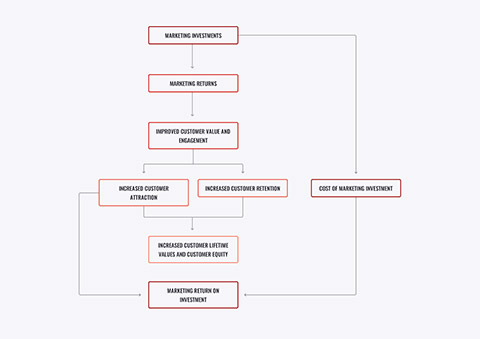
Beyond measuring marketing return on investment in terms of standard performance measures such as sales or market share, may companies now are using customer relationship measures, such as customer satisfaction, engagement, retention and equity. These are more difficult to measure but capture both the current and future performance. The above image displays marketing expenditures as investments that produce returns in the form of these profitable customer relationships. Marketing investments result in improved customer value and satisfaction, which in turn increases customer attraction and retention, further resulting in an increase of the individual customers lifetime values and the firm’s overall customer equity. Increased customer equity, in relation to the cost of the marketing investments, determines return on marketing investment.
Have a look at the information below which reviews the different sections to include in a marketing plan and the purpose they serve to you and other stakeholders when implementing a strategic plan for the marketing process.
| Section | Purpose |
|---|---|
| Executive summary | Brief summary of the main goals and recommendations |
| Current marketing situation | Gives the market description and the product, competition, and distribution review |
| Threats and opportunities analysis | Helps management to anticipate important positive or negative developments |
| Objectives and issues | States and discusses marketing objectives and key |
| Marketing strategy | Outlines the broad marketing logic and the specifics of target markets, positioning, marketing expenditure levels, and strategies for each marketing mix element |
| Action programs | Spells out how marketing strategies will be turned into specific action programs |
| Budgets | Details a supporting marketing budget that is a projected profit-and-loss statement |
| Controls | Outlines the controls that will be used to monitor progress, allow management to review implementation results, and spot products that are not meeting their goals |
Marketing planning involves choosing marketing strategies that will help the company attain its overall strategic objectives. The plan begins with an executive summary that quickly reviews major assessments, goals, and recommendations. The main section of the plan presents a detailed SWOT analysis of the current marketing situation, as well as potential threats and opportunities. The plan next states major objectives for the brand and outlines the specifics of a marketing strategy for achieving them. A marketing strategy consists of specific strategies for target markets, positioning, the marketing mix, and marketing expenditure levels. It outlines how the company intends to create value for target customers to capture value in return. In this section, the planner explains how each strategy responds to the threats, opportunities, and critical issues spelled out earlier in the plan. Additional sections of the marketing plan lay out an action program for implementing the marketing strategy along with the details of a supporting marketing budget. The last section of a marketing plan outlines the controls that will be used to monitor progress, measure return on marketing investment, and take corrective action.
Managing Marketing
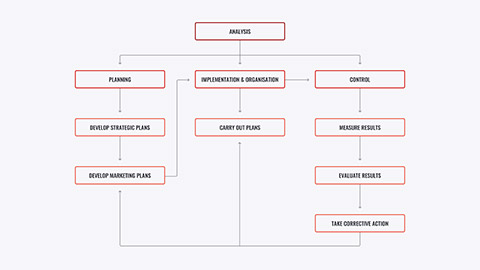
Managing the marketing process requires the four marketing management functions as illustrated in this the above image.
They include:
- analysis
- planning
- implementation
- control.
The company first develops company-wide strategic plans that addresses the what and why of marketing activities, and then is translated into marketing and other plans for each division, product, and brand. Market implementation addresses the who, where, when, and how of marketing activities and this step occurs after the plan has been decided on, the company turns the marketing strategies and plans into marketing actions to accomplish strategic marketing objectives . The Control function consists of measuring and evaluating the results of marketing activities and taking corrective action where needed. Marketing analysis provides the information and evaluations needed for all the marketing functions and activities.
End of topic forum
There are forum activities for this topic. Select the ‘Forum’ at the end of your module (which can be found within your navigation menu) and follow the instructions for each question pertaining to 10 within the forum.
Read the following article relating to the closure of a popular Australian store.
The Sad Final Days of the Last Gap Store in Australia
Further reading:

